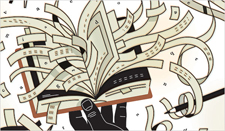You are here
Reading Text in Context
Primary tabs

This in-class exercise encourages students to explore context for texts they are analyzing (rather than receiving such context from direct instruction) and then use visualization software in order to present their findings to their classmates.
This exercise aims to empower students to define textual context that seems important to them at any stage of their encounter with a text.
Students need to have at least briefly encountered the textual object they are trying to contextualize. I usually conduct this exercise after their first section of reading.
The purpose of this exercise is to empower student to explore useful historial context by giving them clear guidelines by which to conduct preliminary research and to introduce visualization tools to implement in presenting that research to their peers. This exercise works best if the instructor has already provided context for class readings on several occassions, giving students an idea of what such a presentation looks like.
I begin by passing out a handout that describes different types of context that students may explore. I then randomly assign students to one of five groups in order to explore and assemble that context into a presentation. Pasted below is a version of this context handout created for Ian Fleming's From Russia With Love:
Context-Building Exercise
GROUP 1 Historical Context
As a group, situate From Russia With Love (1957) within its historical context. What is important to our reading of the novel in the world of politics, science, culture, social movements, or national identity? Is gender important? Is race important? Is sexuality important?
You may use dipity (www.dipity.com) to make a historical timeline that includes pictures or other visuals to present to the class.
Useful Resources: Gale Virtual Reference Library, Wikipedia, scholarly websites/blogs
GROUP 2 Genre/History of Genre
The Bond canon belongs to the genre of the spy novel—but also, arguably, to the history of pulp fiction, thrillers, and adventure novels. How do you see this novel fitting into a genre history?
Useful Resources: Wikipedia, Gale Virtual Reference Library, Johns Hopkins Guide to Lit Theory and Criticism (http://litguide.press.jhu.edu/cgi-bin/search.cgi), scholarly websites/blogs
GROUP 3 Adaptations
The Bond canon has been adapted into many media, including radio, television, film, and comic books. Explore different adaptations of From Russia with Love or other Bond novels and report to the class your findings.
Useful Resources: Wikipedia, YouTube, Google
GROUP 4 Consumer Culture
James Bond is a popular character in consumer culture (that is, culture revolving around things we buy). From video games to artwork to memorabilia, Bond is alive and well in the marketplace. Find objects of consumer culture throughout the history of Fleming’s novels to present to the class, especially objects related to From Russia With Love.
Useful resources:
Google image search, Ebay, Amazon, Etsy
GROUP 5 Reception and Publication History
How was From Russia With Love received? Did it remain in print? How do different printings differ (for instance, how does the cover art change)? Did audience attitudes toward the novel change over time? Find some original reviews and later commentary that tells you something about the reception history of the text.
Useful Resources: Use the Newspaper/Reviews tab here to find original reviews: http://www.lib.utexas.edu/subject/english/index.html
Amazon, Google, Goodreads
I then briefly present Dipity and Prezi to the class and encourage them to use these tools to create an informal presentation in the latter half of class. I also suggeted that Google Docs might be a useful tool in collaborating on the materials they researched to better ease the translation of that material into a final product. I then divide them into five groups--with a full class, this means three or four students per group. Be sure to instruct the class on how long you will give them to complete their presentation and give warnings as that time elapses. Our class is 70 minutes, and so I allowed 35 minute for assembly and 35 minutes for presentations.
In a shorter class, you may ask students to prepare presentations in class one day and present them during the next class period. In a classroom where each student does not have a lab computer, you may ask them to bring their own laptops or give this assignment out in advance, asking students to compile their materials as homework (over Google Docs and/or Prezi, a web-based collaborative presentation software) and present them to each other in class.
As they worked on their presentations, I walked around and checked their progress, answering questions or offering suggestions. When 35 minutes elapsed, I invited groups to the main proctoring station to access their projects and present them to their classmates.
You may want to have some materials ready to suggest for each category in case your students get stuck--but letting students express their own contextual interests in their presentation is crucial to this exercise.
Students need only be familiar with the text they are contextualizing, although you might ask students to familiarize themselves with the visualization softwares above before class.
Because empowering student research and presentation is central to this exercise, be cautious to criticize what students find; rather, praising innovative or clearly relevant material helps demonstrate to them that the details they present are appropriate.
If students feel rushed, emphasize that the exercise is informal and encourage quality collaboration over quantity of information.
I teach a ninety-minute class period of Literature and Popular culture, which is a varient of Literature Across the Disciplines (E314J). The course seeks to explore the intersections of literature and popular culture from the point of view of mass readership and other forms of mass media. The course requires students to consider mediation through the lens of culture, history, and media theory as they engage in close reading and analysis.
-

- Log in to post comments

